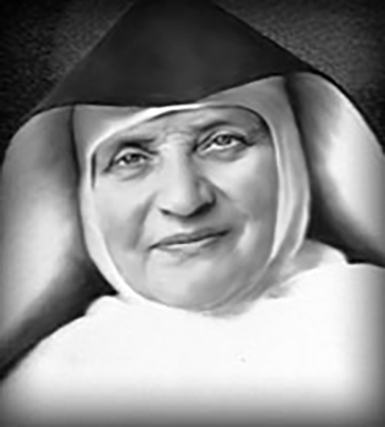Care Packages

Mother Almeda Schricker, SSND

Mother Fidelis Krieter, SSND
How did SSND Internationality Survive World War II?
The war in Germany ended on May 8, 1945. As the reality of Hitler’s atrocities and the suffering of millions became better known, Mother Almeda and her Council were uncertain regarding the future of the School Sisters of Notre Dame. Should they attempt to rebuild an international unity that had been severely challenged during the war? Or would it be better to move toward regional or national restructuring?
The international unity of members serving in various countries had been the vision of Mother Theresa Gerhardinger.
Mother Almeda and her Council had moved from their bombed Munich Motherhouse to the small Marian pilgrimage site in Birkenstein, Germany. As the war ended they were praying for guidance. They asked Mary’s help regarding how to move forward.
Their prayer was answered in a letter delivered by an American officer, a Redemptorist chaplain, who traveled through devastated Germany to find them in Birkenstein.
In a letter of June 15, 1945, Mother Almeda wrote in her circular: “Our Lord’s love-filled heart sent us on the Feast of the Most Sacred Heart of Jesus a wonderful surprise: an American officer, a Father Redemptorist, delivered to us a letter of our very venerable Mother Commissary General, Mary Fidelis from Milwaukee. She writes among other things: ‘Our love and our prayers have been with you in these difficult days. May we ask how we can help? The hearts of your American daughters have been in loving concern with you and our sisters in Europe torn by war. No sacrifice will be too big for us if we only can help you.’
Another sister remembers that Mother Almeda also orally quoted the last sentence of that letter: ‘Even if the whole world lets you down, we will remain faithful to you. Yours, Sister Fidelis.’ Mother Almeda sent Mother Fidelis the addresses of all the missions in Europe asking for care packages, which began to be sent in December 1945.
And it was done.
The following gives specific directions for Care Packages to SSNDs in North America: Source is the Milwaukee Chronicles - June 23, 1947, Mother Fidelis Krieter to Sister Annunciata. Care Packages were to be sent to SSNDs in Bavaria, Austria, Czechoslovakia, Hungary, Italy, Poland, and Rumania.
One package every two months to missions with fewer than ten sisters; one package every six weeks to missions with ten to twenty-five sisters; one package every four weeks to missions with twenty-five to thirty-five sisters; and two packages every four weeks to missions with more than thirty-five sisters.
Gifts from the Heart of Bavaria
In the mission chronicles of the School Sisters of Notre Dame of Bavaria as well as in the letters to Mother Almeda Schricker from the superiors, the many packages from America and Sweden were very gratefully mentioned again and again.
The following is taken directly from the sisters' correspondence. Gratitude was expressed for:
Flower [sic], potato flower [sic], ham, canned sausage and meat, salad oil, lard, rice, bouillon, and soups, rolled oats, baking powder, dry pudding, seasonings, sugar, powdered milk, tea, coffee, cocoa.
Sweets, chocolate, cookies, cod-liver oil, glucose, aspirin and other medications, adhesive bandages. Toys, stationery, laundry soap, soap and soap flakes, toothpaste,
Sewing material, wool, brushes, shoe polish, cleaning rags, towels, toweling, handkerchiefs, baby clothes, clothing for children and adults, shoes and stockings, sweaters, pajamas. Material for habits, veils, and rosaries were also provided.
The text of her letters express the simple gifts that exemplified sisterhood at a time of conflict. Relive these feelings through the excerpts from letters and chronicles.
The Munich Violin
There is a treasured violin that Sister Suzanne Hornung has used for many years. It was first given to her violin teacher, Sister Augustine Hamman. After her death, it was given to Sister Suzanne with the stipulation that she would care for it in a special way. It was a gift from our German Sisters, given to the St. Louis Province by Mother Almeda Schricker in 1950. It was their way of saying "Thank you" for all the Care Packages received during World War II. The "Munich Violin" is easily distinguishable because a tiny paper on the side of the instrument is marked "MUNICH." This anecdote was shared by Sister Suzanne Hornung who played the Munich violin for the author.
Expression of Gratitude of American GIs
The German chronicles also mention that the School Sisters of Notre Dame in Fussen, Germany, received an unexpected gift from American prisoners of war.
Former American prisoners of war who were provided with meals by the Sisters in Fussen sent 20 pounds of soap and detergent, thread and yarn, two dozen handkerchiefs, ten meters of white woolen cloth, three woolen shawls, 20 toothbrushes, sweets, and cocoa. (Bavarian Chronicles)